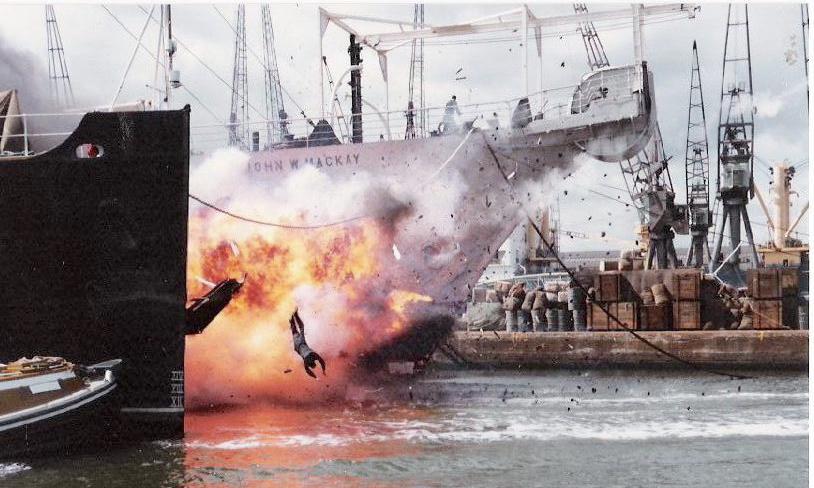
Gillian Aldam began her career as a stunt professional at the age of 22. It was the 1960s, and she had just spent a few years working for a private detective and modelling. But she always loved adventure, including stock car racing, climbing and acrobatics.
“I enjoyed anything that was sporty or tomboyish,” said Aldam, now 83. “I began doing action work after being introduced to a stunt man, and immediately made a name for myself – there were only two other girls doing stunt work at the time.”
Aldam has since had an illustrious career spanning six decades. She doubled for Mary Ure in the film Where Eagles Dare and for Sharon Tate in the Wrecking Crew (both released in 1968), and performed in six James Bond movies including Skyfall (2012).
This week, the contributions of Aldam and other British stunt performers to the film and TV industry is being celebrated with a donation from the British Stunt Register (BSR), a UK-based professional body, to the British Film Institute.
The BSR is giving a rare first edition of its early members directory from 1973 to the BFI Reuben Library. It includes the biggest names in the stunt world, such as Aldam, alongside the likes of Reg Harding (Indiana Jones), Cyd Child (The Avengers), Richard “Dicky” Graydon (James Bond), Joe Powell (The Man Who Would be King) and Jim Dowdall (Saving Private Ryan).
“Stunt work has massively changed since when I first started out,” Aldam said. “Then, you were just asked if you could do the job. You signed a blood chip to say you were responsible for your own accidents. There were no wires or protection.”
According to Dowdall, much of the progress in the stunt profession is because of the founding of the BSR by performers in 1973.
Before then, stunt artists worked as extras on films and were given additional pay for performing a “gag” such as falling down the stairs, crashing a car or being involved in a fight sequence. The work often attracted former military personnel, professional horse riders, exhibition divers, circus performers, boxers and wrestlers. Work often came through word-of-mouth introductions.
But the directory created a pool of stunt professionals, and helped introduce better safety protections. These days, to join the register and become a BSR-qualified stunt performer, you need qualifications across at least six different sporting areas in four of the following groups: fighting (compulsory), falling, riding and driving, agility and strength, or water.
“There was no health and safety before,” said Dowdall, who is a former chair of the BSR committee. “Now things have tightened up hugely. The equipment got better, personal pads got better. We fall on airbags instead of cardboard boxes.”
His own career has been one long rollercoaster ride. Before entering the stunt business, he worked in the circus for a lion trainer and as an acrobat, was an armourer for films, and spent time in the Parachute regiment. He has doubled for Harrison Ford in Force 10 from Navarone (1978) and Hanover Street (1979), Roger Moore in Octopussy (1983) and Pierce Brosnan in GoldenEye (1995) and Die Another Day (2002).
“On Octopussy I was running and fighting on top of a train,” said Dowdall, now 75. “In Die Another Day, I was in the Aston Martin on the ice.” Many of these stunts have been highly dangerous. Dowdall almost broke his neck falling down a well once.
Doubling as Tate on Where Eagles Dare, Aldam said she once had to “step out from a moving cable car at 70ft up with nothing other than 8ft of water to drop into”. She also recalled doubling for Deborah Kerr in the 1967 spoof Bond film Casino Royale, when she had to escape from a castle in wellington boots and a black neglige and nighty. “I came off on a swinging pipe at a height of 80ft.”
Aldam has had her fair share of serious injuries. During a sequence for The Wrecking Crew – during which she and a colleague had to land a helicopter at 40 mph on to the back of the container lorry on a freight wagon – she fell and broke her back in three places, as well as her collarbone, shoulder blade and six ribs.
“A telephone cable snapped and wound around my throat. I slid backwards as the container lorry went out from under me, and I remember seeing the ground and hitting it with my shoulder. They had to withdraw 400cc of blood from my punctured lung. I was 2cm from being paralysed from the waist down,” Aldam said.
Fourteen weeks later, she was back at work. It’s only now that she ready to slow down.
In 2023, Aldam performed in the films Wicked part 2, Blitz and Old Guy and the TV spy thriller Slow Horses in the space of a few months. “So you could say I’m going out on a high”, she said with a laugh. “My daughter is an intensive care consultant, and she’s appalled by me still working at this age. She says: ‘I’m the one who puts them back together, mother.’”
The BFI said the gift of the directory came from a relationship forged through its recent Art of Action film season. The 1973 directory will be catalogued, digitised for viewing access and preserved as part of the Reuben library’s Ariston collection.
Stunt performers hope this is the beginning of a new era of respect and recognition for their work. Despite the artistry and risks involved in professional stunt work, for example, there is still no special category at awards ceremonies such as the Baftas and Oscars.
“Every other department is recognised: wardrobe, hair, makeup, sound, but we’re not,” Dowdall said.
Aldam added: “We deserve our own category, especially when even people like Tom Cruise are doing stunts now. Everybody I’ve worked with has always given their best. The least we deserve is a little bit of recognition.”


Post a Comment
0Comments